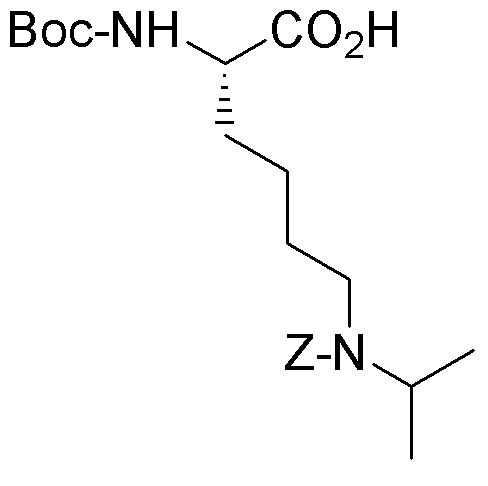Na-Boc-Ne-isopropyl-Ne-Z-L-lysine is widely utilized in research focused on:
- Peptide Synthesis: This compound serves as a key building block in the synthesis of peptides, particularly in the development of biologically active compounds. Its protective groups facilitate selective reactions, making it easier to construct complex peptide structures.
- Drug Development: In pharmaceutical research, it is used to create novel drug candidates. The compound's unique structure allows for modifications that can enhance drug efficacy and specificity, particularly in targeting specific biological pathways.
- Bioconjugation: It plays a significant role in bioconjugation techniques, where it can be used to attach biomolecules to drugs or imaging agents. This application is crucial in developing targeted therapies and diagnostic tools in medicine.
- Protein Engineering: Researchers use this compound in protein engineering to modify lysine residues, improving protein stability and functionality. This is particularly beneficial in the production of therapeutic proteins.
- Research in Cancer Therapy: The compound is being explored in cancer research for its potential to create targeted therapies that can selectively attack cancer cells while minimizing damage to healthy tissues, offering a promising avenue for more effective treatments.
General Information
Properties
Safety and Regulations
Applications
Na-Boc-Ne-isopropyl-Ne-Z-L-lysine is widely utilized in research focused on:
- Peptide Synthesis: This compound serves as a key building block in the synthesis of peptides, particularly in the development of biologically active compounds. Its protective groups facilitate selective reactions, making it easier to construct complex peptide structures.
- Drug Development: In pharmaceutical research, it is used to create novel drug candidates. The compound's unique structure allows for modifications that can enhance drug efficacy and specificity, particularly in targeting specific biological pathways.
- Bioconjugation: It plays a significant role in bioconjugation techniques, where it can be used to attach biomolecules to drugs or imaging agents. This application is crucial in developing targeted therapies and diagnostic tools in medicine.
- Protein Engineering: Researchers use this compound in protein engineering to modify lysine residues, improving protein stability and functionality. This is particularly beneficial in the production of therapeutic proteins.
- Research in Cancer Therapy: The compound is being explored in cancer research for its potential to create targeted therapies that can selectively attack cancer cells while minimizing damage to healthy tissues, offering a promising avenue for more effective treatments.
Documents
Safety Data Sheets (SDS)
The SDS provides comprehensive safety information on handling, storage, and disposal of the product.
Product Specification (PS)
The PS provides a comprehensive breakdown of the product’s properties, including chemical composition, physical state, purity, and storage requirements. It also details acceptable quality ranges and the product's intended applications.
Certificates of Analysis (COA)
Search for Certificates of Analysis (COA) by entering the products Lot Number. Lot and Batch Numbers can be found on a product’s label following the words ‘Lot’ or ‘Batch’.
*Catalog Number
*Lot Number
Certificates Of Origin (COO)
This COO confirms the country where the product was manufactured, and also details the materials and components used in it and whether it is derived from natural, synthetic, or other specific sources. This certificate may be required for customs, trade, and regulatory compliance.
*Catalog Number
*Lot Number
Safety Data Sheets (SDS)
The SDS provides comprehensive safety information on handling, storage, and disposal of the product.
DownloadProduct Specification (PS)
The PS provides a comprehensive breakdown of the product’s properties, including chemical composition, physical state, purity, and storage requirements. It also details acceptable quality ranges and the product's intended applications.
DownloadCertificates of Analysis (COA)
Search for Certificates of Analysis (COA) by entering the products Lot Number. Lot and Batch Numbers can be found on a product’s label following the words ‘Lot’ or ‘Batch’.
*Catalog Number
*Lot Number
Certificates Of Origin (COO)
This COO confirms the country where the product was manufactured, and also details the materials and components used in it and whether it is derived from natural, synthetic, or other specific sources. This certificate may be required for customs, trade, and regulatory compliance.


